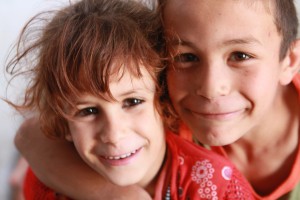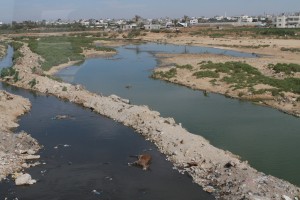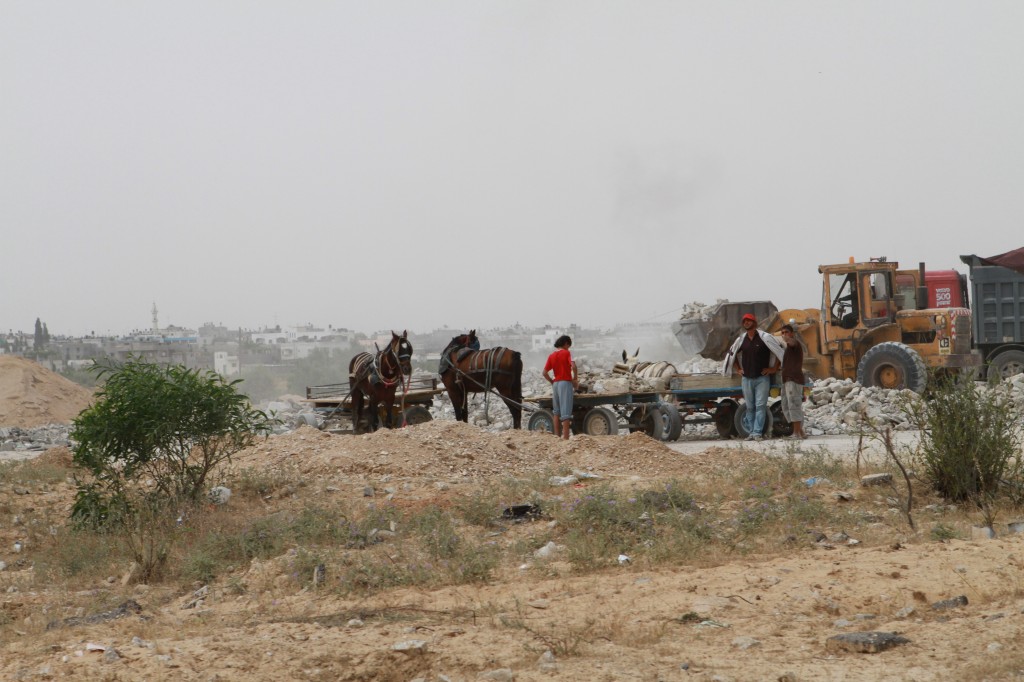Guest blog by Gerri Haynes: Reflections on the Public Health Crisis in Gaza, 2010
(Gerri will give a report on the current situation in Gaza at the Northlake Unitarian Universalist Church in Kirkland at 7 p.m. on Tuesday, June 22.)
In May, 2010, I traveled to Gaza with eight other members of Physicians for Social Responsibility to work with medical colleagues in hospitals and clinics. This land has been under siege by Israel for more than three and one half years. The passage of essential goods into and out of Gaza is severely restricted by guarded walls, fortified gates and a sea blockade enforced by Israel.
The World Food Programme reports that 80% of households in Gaza depend on international food aid. The Palestinian Health Ministry recently reported that 70% of Gaza’s residents suffer from anemia. Ard Al-Insan, a health organization in Gaza City, states that 10.4% of households in Gaza City suffer from chronic malnutrition.

Children with normally brown hair show signs of malnutrition in reddened hair, pale skin, short stature. (photo by Bob Haynes)
Reflecting on what we heard and saw, and the possibility that there may be some positive benefits to the opening of the siege on Gaza in the wake of the Free Gaza flotilla tragedy, this article is a review of some of the critical issues and some possible solutions for the public health of Gaza.
Water
Gaza is a semi-arid land; the over-all rainfall is approximately 317 mm/year and this is decreasing through drought. (The average rainfall is Seattle is 920 mm/year.) The groundwater aquifer, sole source of water, which extends from Haifa to the Sinai, is not being adequately replenished by rainfall. Also, according to Gaza Municipalities, Israel has constructed wells along the eastern part of the Gaza strip to catch the flow of water before it enters Gaza, and Israel has built dams along the Gaza valley to collect the flow of rainwater outside of Gaza for use by Israel.

The United Nations reports that 90 – 95 percent of Gazans do not have access to clean water. (photo by Bob Haynes)
The United Nations reports that 90 – 95 percent of Gazans do not have access to clean water. Untreated and partially treated sewage is seeping into the soil and the aquifer and flowing directly into the Mediterranean.
Lacking basic equipment, spare parts and adequate electricity because of the siege by Israel, the sewage treatment system of Gaza is unable to handle the level of sewage that needs to be processed.
Fishing, a primary source of income and food in the past, is restricted by the blockade – deep water fishing is closed to Gaza and fishing in the nearby shallow, polluted water yields an inedible catch.
To remedy the water crisis, construction of sewage treatment and desalination plants will be essential. This will require access to Gaza by sea or through Israel and/or Egypt in order to bring in critically needed equipment.
Also, given the present level of unemployment and poverty (70% below the poverty line), financial aid from the international community will be required.
Air
Based on observation and anecdotal evidence, the air quality in Gaza is poor. The absence of reliable electricity (bombing by Israel of Gaza’s power plant in 2006, the unavailability of repair parts due to the siege and lack of fuel to run the functioning parts of the power plant) results in power cuts that last from four to eight hours per day for all of Gaza. The use of small, private generators is wide-spread and the resulting pollution of the air is felt throughout the region – concentrated in the cities where the population also is concentrated.
Physicians report a high incidence of burns from touching generators and pouring gasoline into generator fuel tanks and that childhood asthma is rapidly increasing. Whether the increase in asthma is caused by poor air quality or pollutants from other sources is under study.
Soil
In parts of Gaza the groundwater and the soil are contaminated with nitrites, from pesticides and sewage, and chlorides, from seawater intrusion. Both carry health risks, particularly to developing fetuses and small children.
Mental Health
The presence of the siege, profound lack of employment, death of loved ones through air and ground attacks, presence of continuing disabilities from injuries sustained in those attacks, death and injuries caused by fighting inside Gaza, and the ongoing threat of further attacks by Israel have created a sense of despair, tension and fear – and a level of hopelessness in the population of Gaza.
Every person our group spoke with had been affected by the siege and the 2008/2009 attacks by Israel. While the pervasive belief that “all things come from Allah” provides comfort, the daily life of the average person in Gaza is fraught with difficulties.
Mental health workers describe seeing what has been reported in the homes of U.S. war veterans: increased rates of episodic rage and domestic abuse. They also report high rates of depression and an inability to find hope in any activity among the people of Gaza.
However, during our visits to women’s clinics and during our work in health care facilities, a sense of resilience was palpable. Innovative efforts to overcome the health crisis go on despite desperate conditions. The Gaza Community Mental Health Programme – host to our delegation – is developing a program to teach primary care providers how to assist patients in recognizing normal responses to the abnormal situation of life in
Gaza.
Ultimately, the most essential remedy for the public health crisis in Gaza is to end the collective punishment of the population by ending the siege. Among many other things, this will allow the resumption of trade which will create jobs in Gaza and lead to the revival of hope for a healthier future.

Local Palestinians harvest building materials of questionable toxicity from the rubble of bombed buildings. (photo by Bob Haynes)
1 Comment to “Guest blog by Gerri Haynes: Reflections on the Public Health Crisis in Gaza, 2010”
RSS feed for comments on this post. TrackBack URI
By Jane, June 23, 2010 @ 1:06 pm
Dear Gerri,
Thank you so much for your speech and organizing the event last night.
I was deeply moved by each one of you who traveled to GAZA and finding the truth.
I called UC.Irvin for your possible visit at 949-824-5011, and Office and Technology Department 949-824-5123. I think they’ll get back to me. This university compass had great Israeli and Palestinian conflicts, so I think it is more necessary for you to visit there and bring the important message for PEACE.
I will also talk to our Amnesty International group here and see if you can also make a speech in our group.
Love and peace,
Jane J
206-792-5526
http://www.youtube.com/user/ZiYouZhongGuo